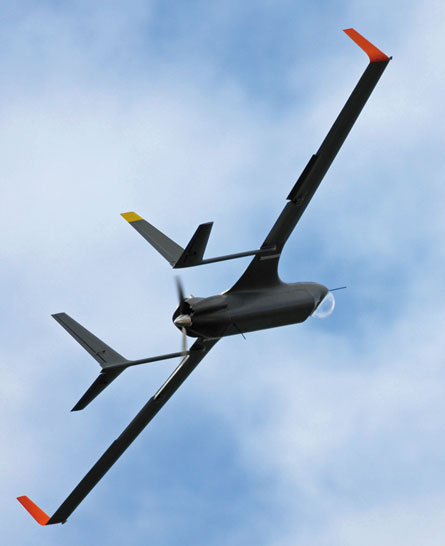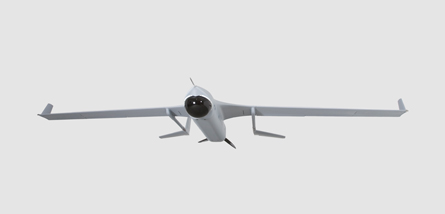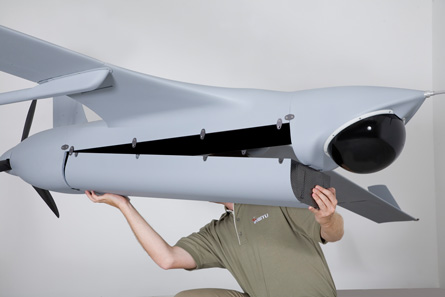Not content to rest on its Scan Eagle laurels, US-based Insitu is about to take its next step in UAVs and aims to tap the market's commercial potential
Five years after helping define and then establish a services market for military unmanned air vehicles in conjunction with Boeing, Washington state-based Insitu is about to unveil a new-generation aircraft designated Integrator.
The company is also preparing to launch a new research and development effort in co-operation with the US Air Force to continue to evolve its Insight UAV, better known as Scan Eagle. That effort, now in the contract negotiation phase, includes provisions for the first military assessments of the Integrator and its potential battlefield application.

Insitu also sees a commercial future for the new UAV, including as a potential element of its strategic alliance with Evergreen.
Development of the Integrator has been under way for three years as a company-funded initiative aimed at an aircraft with a much-improved payload compared with the Insight and other vehicles in its class. The UAV has a 900 x 255mm (36 x 10in) payload bay and multiple external hardpoints.
The design retains the Insight's wing platform and fuselage, but is significantly larger, with a 4.8m span and a 59kg (130lb) maximum take-off weight. It also has twin tail booms with outboard stabilisers in a configuration suggestive of the Burt Rutan-designed SpaceShipOne and Proteus aircraft.
A prototype Integrator first flew in 2006, and production-standard aircraft are in advanced development. The UAV being unveiled at this week's Association for Unmanned Vehicle Systems International's Unmanned Systems North America show in Washington, DC has the production airframe geometry and outer mould lines.
Steve Nordlund, vice-president business development and programme management, says the new UAV reflects the maturing of the Insight design and its success in the military market. "One of our goals was to get Scan Eagle to a stage where it was starting to get well integrated into our customer's missions, and as we did that we gained a lot of knowledge. We wanted to introduce a second product, but the timing of it, from a business standpoint, is important. We felt that Scan Eagle has reached a stage, working with Boeing, where it has over 50,000 mission hours, so it is a proven unmanned air system. It was time to look at our next product launch."
In its Scan Eagle configuration, the Insight helped mature military definitions of what constitutes a small tactical-class UAV, says Nordlund, with the aircraft initially sitting outside the standard hierarchical model because of its endurance capabilities.
Now Scan Eagle is widely seen as a reference design for the US military's Tier II tactical-class UAV. "Scan Eagle helped define those tiers and discover that at a battalion level or even lower you could have an organic long-endurance intelligence, surveillance and reconnaissance asset," says Nordlund.
BLOCK CHANGES
To achieve its capability, the Insight/Scan Eagle required a highly integrated design with little room in the earlier production models for alternative payloads or system changes. Three subsequent block changes have allowed for greater flexibility, including modular fuselage "plugs". The latest version, Block D, has a 60mm-long module ahead of the engine to support additional avionics - specifically a Mode C transponder - and "plug and play" nose section modules that can support different electro-optical sensor types.
Nonetheless, says Nordlund, the UAV remains a "tightly integrated system. As we looked at our next product we looked at how we could have all the benefits of Scan Eagle, including interoperability - which is the goal we are working towards - but give our customers additional flexibility in the areas of payload. That is really the main thrust behind it."
|
|---|
Integrator's forward profile has close similarities with Insight, reflecting its design lineage |
Insitu chief technology officer Charlie Guthrie says that "as we have moved towards the Integrator, the capability that we were trying to provide is in one sense to be the pick-up truck of this class. We took a strong focus on ease of integration of anybody's and everybody's payloads while retaining the benefits of Scan Eagle." The new UAV will also reuse the Insight/Scan Eagle ground control and mission data processing architecture.
Dr Jay Gundlach, Insitu vice-president of advanced development, says the basic Integrator configuration was frozen in November 2005. This included enabling the modular airframe to be stored and transported in a container only slightly larger than that now used for the Insight. The new UAV is also designed for rapid assembly and disassembly by one operator. That requirement influenced the design of the twin tail. "A twin connected tail might require two people. Also, we wanted to be able to start the engine and do engine maintenance without the interference of the tails," he says.
The UAV will be launched and recovered using new-generation ground equipment based on the Scan Eagle systems, including Insitu's patented Skyhook capture mechanism. But the new hardware will be much lighter compared with existing Insight ground-handling systems, and be able to operate both UAV types.
MODULAR JOINING
Integrator's fuselage will use the same modular joining system used in current production Insight/Scan Eagle aircraft, meaning it can be rapidly modified to meet mission requirements. "With Scan Eagle, we can expand the configuration in the front and the back of the aircraft with this we can expand it downwards by changing the outer mould line of the aircraft within the payload geometry. And just like Scan Eagle we can extend it fore and aft. The modular design also allows us to rapidly change the wings, so if we wanted to go with a longer-endurance variant, a simple wing and tail change would allow that."
The propulsion system is also configured as a module to allow for rapid swap-out. Several engines are being assessed for the production UAV. "We have done flight tests on one engine and that would be suitable. However, we are coming up with two advanced engine choices. One is off-the-shelf that we would modify. The other we are doing in-house."
Gundlach says heavy fuel options form part of the long-term growth plan for the UAV. "Long term for us," quips Nordlund, "is not like long term for everybody else."
The Integrator flight envelope "is almost identical to that of Scan Eagle", says Gundlach. "Although we have the heavier wing loading, the conventional configuration allows us to fly higher than the competition so we can slow down. The launch and capture speeds are all the same, the cruise speed is about the same. The maximum level speed is going to be about 90kt [165km/h] and our altitude capability is going to go up to about 20,000ft, just like we can on Scan Eagle."
The initial market focus for Integrator will remain the military, says Nordlund, and will be pursued directly by Insitu as well as via its ongoing strategic relationship with Boeing. "The military market will be the first to jump on board because of the attributes and the capabilities that it presents." Boeing has been kept fully aware of Integrator development, although the strategic agreement between the two firms is now focused solely on Scan Eagle. "It is not part of our current teaming agreement with Boeing, but that doesn't mean that we don't work with them on it," says Nordlund.
Integrator's inclusion in the US Air Force's planned Insight/Scan Eagle advanced concepts development programme was made public in June. The USAF says the programme aims to "enhance the capabilities of the Scan Eagle unmanned air systemand to perform advanced technology development and demonstrations exploring emerging capabilities for both the Insight and Integrator UAS. The effort will look across multiple mission and technology areas: sensors, sensor performance, control, communications, weaponisation, reliability, sense and avoidance, and payload reutilisation, with an effort to maintain commonality of capability between Insight and Integrator."
The project is also to support US Navy requirements, including "training, and support for the development of new concepts of employment/operations and tactics, techniques, and procedures. Finally, the effort will include the integration, demonstration, development, and enhancement of payloads to improve shipboard situational awareness and intelligence-gathering missions."
|
|---|
Integrator has been designed around maximising its payload bay space |
The USN-developed Spike miniature missile is identified as a potential weapons payload and a miniature synthetic-aperture radar payload could be tested.
UAV battlelab
Nordlund says contract negotiations are still under way, and flow directly from work over the past two years with the former USAF UAV Battlelab as well as with the Air Force Research Laboratory. "What they have been helping us with and what we have been working on is adding capabilities to the system."
Gundlach says the USAF is "interested in the payload integration aspects of the new platform. One of the things we are anticipating is a substantial effort that will go towards initial development of the EO/IR ball and several payloads that we might be able to fly. There are advances to control stations, muffler technologies etc, that will be applicable to the Integrator, as well in future to Scan Eagle."
Development of a civil market for Integrator faces the same challenges as with Insight, Nordlund says: "I think that as the regulatory framework around the world for integration of unmanned systems happens, and customers become creative in what their needs are, the marketplace will help define where that product fits more than the manufacturer will. "
Insitu is exploring options for how best to position Integrator, with choices ranging from direct sales or services through to strategic relationships like that being negotiated with Evergreen, says Nordlund. "Their focus is on the commercial side", but both firms have similar corporate outlook, he says. "There are a lot of similarities between the culture of our organisations it just happens we are 60 miles apart, which is rare in this industry, but is very nice."
Check out flight's UAV directory
Source: Flight International


















